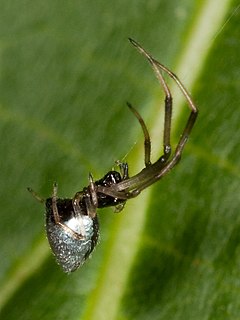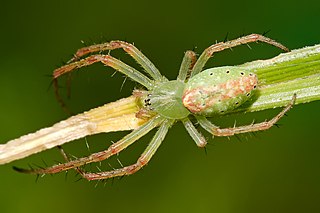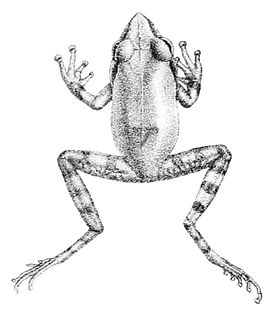
Theridiidae, also known as the tangle-web spiders, cobweb spiders and comb-footed spiders, is a large family of araneomorph spiders first described by Carl Jakob Sundevall in 1833. This diverse, globally distributed family includes over 3,000 species in 124 genera, and is the most common arthropod found in human dwellings throughout the world.
Epidelaxia is a genus of Asian jumping spiders that was first described by Eugène Louis Simon in 1902. Once considered completely endemic to Sri Lanka, another species was discovered from Philippines in 2016.

Nephilinae is a spider subfamily of the family Araneidae with seven genera. The various genera in Nephilinae were formerly grouped in the family Nephilidae, and before that in the Tetragnathidae and in the Araneidae. All nephiline genera partially renew their webs. Spiders in the subfamily Nephilinae are commonly referred to as golden orb-weavers.

Argyrodes, also called dewdrop spiders, is a genus of comb-footed spiders that was first described by Eugène Louis Simon in 1864. They occur worldwide, and are best known for their kleptoparasitism. They can spin their own webs, but tend to invade and reside in their hosts' webs. This relationship can be commensal or even mutual if the dewdrop spider feeds on small trapped insects that are not eaten by the host. Some species can even prey upon the host.

Cyrtophora, the tent-web spiders, is a genus of orb-weaver spiders first described by Eugène Simon in 1895. Although they are in the "orb weaver" family, they do not build orb webs. Their tent-like, highly complex non-sticky web is sometimes considered a precursor of the simplified orb web. These webs are aligned horizontally, with a network of supporting threads above them. These spiders often live in colonies. Females have a body length of mostly about 10 millimetres (0.39 in) long. Some members, including Cyrtophora cicatrosa, exhibit the ability to change colour rapidly.
Argyrodes argentatus is a kleptoparasitic spider.

Poecilotheria is a genus of Asian tarantulas that was first described by Eugène Louis Simon in 1885. They are arboreal tarantulas, commonly known as ornamental tarantulas, known for their vivid color patterns, fast movement, and potent venom compared to other tarantulas. As of 2019 all species are protected under CITES.

Pseudophilautus nasutus was a species of frog in the family Rhacophoridae. It was endemic to Sri Lanka where it is extinct, though it might occur or have occurred in India too.

Argyrodes flavescens, commonly called the red and silver dewdrop spider is a species of spider belonging to the family Theridiidae. It is widely distributed in Southeast Asia and is also found in Sri Lanka. Like other members of this genus, this species is a kleptoparasite, living on the web of a larger spider and feeding off its prey. A. flavescens most commonly inhabits the webs of araneids.
Wildlife of Sri Lanka includes its flora and fauna and their natural habitats. Sri Lanka has one of the highest rates of biological endemism in the world.
Diplothele is a genus of mygalomorph spider in the family Barychelidae, containing four species restricted to India and Sri Lanka.
Pholcus fragillimus, is a species of spider of the genus Pholcus. It is distributed from Sri Lanka, India to Japan. The type material of Pholcus fragillimus has probably been destroyed in Stuttgart during the Second World War, and only one female is available now in museums.
Wanniyala is a genus of cellar spiders native to Sri Lanka, first described by Huber & Benjamin in 2005. They have six eyes and four pair of legs and grow up to 2 mm in length. The abdomen is globular and males have a distinctive distal hinged sclerite on the procursus of genitalia. The name is derived from the Sri Lankans native to the island that the first spiders were found on- the Vedda people- and their surname Wanniyala-Aetto.
Aprusia is a genus of goblin spiders in the family Oonopidae, containing five accepted species. four species are endemic to Sri Lanka and the other species is endemic to India.
Argyrodes fissifrons, the split-faced silver spider, is a species of spider of the genus Argyrodes. It is found in Sri Lanka to China and Australia.
Argyrodes scintillulanus, is a species of spider of the genus Argyrodes. It is native to India and Sri Lanka.

Neospintharus is a genus of comb-footed spiders that was first described by H. Exline in 1950. It was synonymized with Argyrodes in 1962, but revalidated in 2004.

Argyrodes elevatus, commonly referred to as dew-drop spider, is part of the family Theridiidae that consists of more than 3,000 species. These spiders are most commonly found in subtropical and tropical regions in South and Central America, as well as southern regions of the United States. One of the key distinguishing characteristics of A. elevatus is its kleptoparasitic behavior through which it primarily procures food for survival. Typically 1 or 2 A. elevatus spiders preside in outer areas of webs built by other species of spiders, although it is possible for up to 45 spiders. There are two main mechanisms by which A. elevatus raid the hub of the host’s web to steal insects preyed and wrapped by the host spider. A. elevatus follows an intricate course to the hub of the web to search for prey, using vibrational detection enhanced by laid out threads along the web to find and capture the insect. These spiders are highly efficient, with the theft lasting a maximum of 12 seconds and high success rates. This reliance on a host spider for food has led to adaptations in sleep schedules and alternate food sources to revolve around the host species activity. A. elevatus display a unique courtship routine in which male A. elevatus presents prey wrapped in silk as a nuptial gift to the female spider. The male spider approaches the female, carrying the nuptial gift on its chelicerae while communicating with a distinct courting vibration, followed by copulation. Approximately twenty-four hours after the A. elevatus courtship and copulation series of events, the female spider will lay one to two eggs on the outer regions of the host's web.








